Metaphysics | 玄学
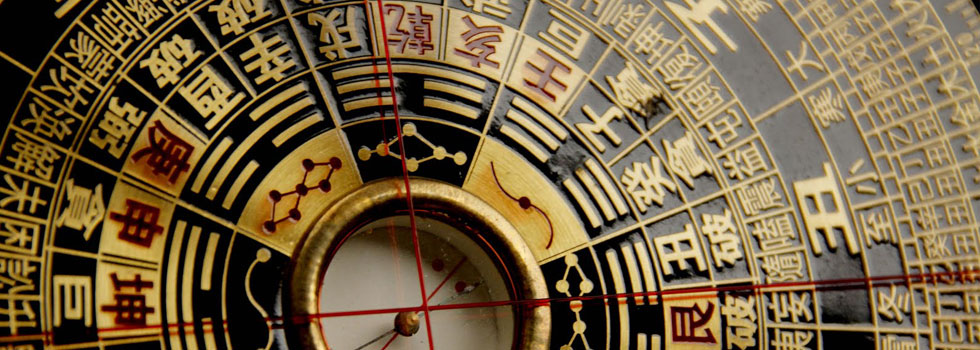
Metaphysics is a traditional branch of Daoism concerned with explaining the fundamental nature of being and the world that encompasses it. The methods include :
Zhouyi | 周易
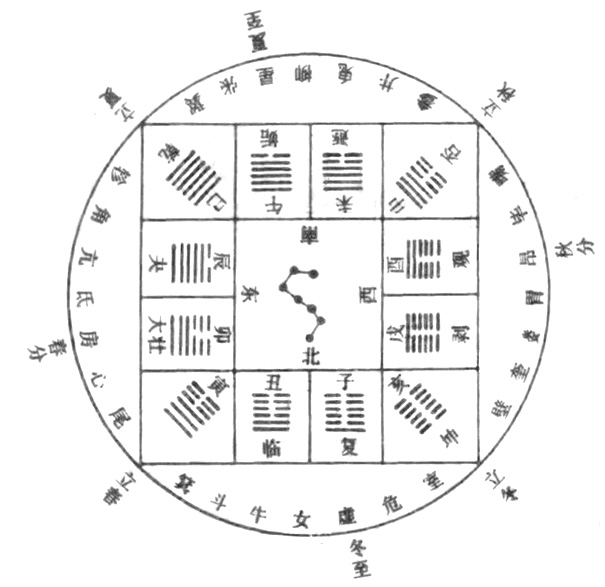 The Yijing (易經) or Zhouyi (周易), also known as the Classic of Changes or Book of Changes, is an ancient divination text and the oldest of the Chinese classics. The Yijing was originally a divination manual in the Western Zhou period, but over the course of the Warring States period and early imperial period was transformed into a cosmological text with a series of philosophical commentaries known as the "Ten Wings". Zhou dynasty divination was grounded in cleromancy, the production of seemingly random numbers to determine divine intent.
The Yijing (易經) or Zhouyi (周易), also known as the Classic of Changes or Book of Changes, is an ancient divination text and the oldest of the Chinese classics. The Yijing was originally a divination manual in the Western Zhou period, but over the course of the Warring States period and early imperial period was transformed into a cosmological text with a series of philosophical commentaries known as the "Ten Wings". Zhou dynasty divination was grounded in cleromancy, the production of seemingly random numbers to determine divine intent.
The Zhou yi, which may be grounded in even older Shang dynasty analysis of oracle bones, contains references to events as early as the 11th century BC. The basic unit of the Zhou yi is the hexagram (卦 guà), a figure composed of six stacked horizontal lines (爻 yáo). Each line is either broken or unbroken. The received text of the Zhou yi contains all 64 possible hexagrams, along with the hexagram's name (卦名 guàmíng), a short hexagram statement (彖 tuàn), and six line statements (爻辭 yáocí).
Wuxing Yi | 五行易
Wuxing Yi (五行易) or Wen Wang Gua (文王卦) is a method of interpreting the results of Yi Jing divination that was first described in writing by Jing Fang (78–37 BC) in Han dynasty China. It is based on correlating trigrams to the celestial stems and Earthly Branches of the Chinese calendar, and then using the stem and branch elements to interpret the lines of the trigrams and hexagrams of the Yi Jing.
Meihua Yi Shu | 梅花易數
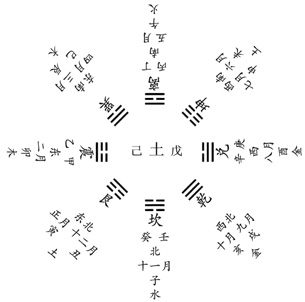 Meihua Yishu (Plum Blossom Yi Numerology) is an Yijing type of divination method developed by Shao Yong(1011-1077) in Song Dynasty of China. Although Shao Yong (Shao Kangjie) was born into poverty, unlike most scholars/philosophers of the time, he was able to study and learn through borrowing books as he traveled afar. Eventually, Master Shao Yong came upon the Yi Jing (Book of Changes), on which he would dedicate many decades of study and contemplation. He later established his own system, “The Earlier Heaven Yi,” based off of Fu Xi’s arrangement of the eight primary Qua and explained it in the book Huang Ji Qing Shi. Master Shao Yong also summarized the findings of preceding I Ching philosophers and rearranged the 64 Qua into both square and circular patterns. Additionally, he was well known as an adept predictor of future events through the use of mathematics and perception through Mei Hua Yi Shu.
Meihua Yishu (Plum Blossom Yi Numerology) is an Yijing type of divination method developed by Shao Yong(1011-1077) in Song Dynasty of China. Although Shao Yong (Shao Kangjie) was born into poverty, unlike most scholars/philosophers of the time, he was able to study and learn through borrowing books as he traveled afar. Eventually, Master Shao Yong came upon the Yi Jing (Book of Changes), on which he would dedicate many decades of study and contemplation. He later established his own system, “The Earlier Heaven Yi,” based off of Fu Xi’s arrangement of the eight primary Qua and explained it in the book Huang Ji Qing Shi. Master Shao Yong also summarized the findings of preceding I Ching philosophers and rearranged the 64 Qua into both square and circular patterns. Additionally, he was well known as an adept predictor of future events through the use of mathematics and perception through Mei Hua Yi Shu.
Fengshui | 風水数术
Fengshui is a system of harmonizing all matter with their surrounding environments. The practice has a long history with to before the formation of Chinese civilization with the Neolithic culture of Yangshao and Hongshan over 3,500 years ago. In the Zhou Dynasty (1122–770 BCE), the astronomical correlations and principles of Fengshui were used to calculate appropriate time to build a capital and the position of structures around the city. Since many if not all of capital cities in China followed the rules of Fengshui for design & layout. Throughout history different schools such as the older Form School (形势派, focuses on the shape of the environment, the five elements and yin/yang to find a place with ideal qi) and the latter Compass School (理气派 known for its Flying star & eight mansions techniques).
Taiyi Shenshu | 太乙神數
Tai Yi Shen Shu is used to predict macroscopic events like wars or the meaning of supernovae. One form of Tai Yi Shen Shu has been popularized over the centuries to predict personal fortunes. Genghis Khan, emperor of China (Yuan Dynasty), referred to Tai Yi at one point to decide whether or not his planned invasion of Japan would succeed. When the Tai Yi count indicated that invasion would prove unsuccessful, Khan decided not to invade Japan that year. The art makes use of the 8 trigrams as well as the 64 hexagrams as a foundation, analysis is conducted from the Tai Yi Cosmic Board and the array of symbols found thereon, with special reference to the position of symbols in specific palaces.
Qimen Dunjia | 奇門遁甲
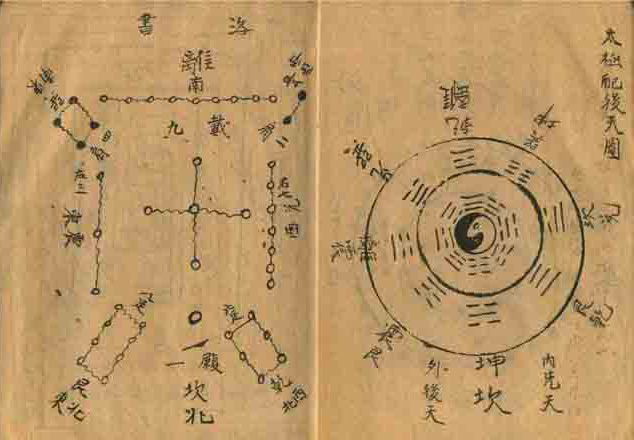 The Qi Men Dun Jia cosmic board consists of a 3 × 3 magic square of nine palaces, which includes a Heaven and Earth pan, a spirit pan, eight gates and a star pan. The various symbols rotate around the palaces with each double hour, making a total of 1,080 different configurations of the Qi Men Dun Jia cosmic board. These "ju" or situations are recycled four times per year, and are divided between the Yin and Yang halves of the year. Qimen Dunjia (Mysterious Gates Escaping) Technique was originally devised to help form military strategy and tactics, Qi Men Dun Jia was in use as long ago as the period of Chinese history known as the Warring States, and is believed by Chinese scholars to have been used at the Battle of Red Cliffs in the defeat of Cao Cao's ship-borne army. Liu Bowen is believed to have secured the throne for the Ming emperor by applying Qi Men Dun Jia to his strategic planning. Over the centuries of Chinese history, Qi Men Dun Jia grew in popularity and was expanded to include a number of other types of divination, including medical divination, matchmaking, childbirth, travel, personal fortunes, and today includes contemporary applications, most notably, that of business and finance.
The Qi Men Dun Jia cosmic board consists of a 3 × 3 magic square of nine palaces, which includes a Heaven and Earth pan, a spirit pan, eight gates and a star pan. The various symbols rotate around the palaces with each double hour, making a total of 1,080 different configurations of the Qi Men Dun Jia cosmic board. These "ju" or situations are recycled four times per year, and are divided between the Yin and Yang halves of the year. Qimen Dunjia (Mysterious Gates Escaping) Technique was originally devised to help form military strategy and tactics, Qi Men Dun Jia was in use as long ago as the period of Chinese history known as the Warring States, and is believed by Chinese scholars to have been used at the Battle of Red Cliffs in the defeat of Cao Cao's ship-borne army. Liu Bowen is believed to have secured the throne for the Ming emperor by applying Qi Men Dun Jia to his strategic planning. Over the centuries of Chinese history, Qi Men Dun Jia grew in popularity and was expanded to include a number of other types of divination, including medical divination, matchmaking, childbirth, travel, personal fortunes, and today includes contemporary applications, most notably, that of business and finance.
Da Liu Ren | 太乙大六壬
This divination form is called Da Liu Ren because in the Sexagenary cycle there are Six Rens (Renshen, Renwu, Renchen, Renyin, Renzi, Renxu) each with a different branch. Along with the divination methods Qi Men Dun Jia 奇门遁甲 and Taiyi 太乙—collectively known as the "Three Styles" (San shi 三式)—Da Liu Ren is considered in China to be one of the highest forms of Chinese metaphysics. The Da Liu Ren cosmic board contains positions for the Earth pan and Heaven pan, which hold the twelve Earth Branches and the twelve spirits. In addition, the Da Liu Ren cosmic board indicates the Three Transmissions (san chuan 三传) and Four Classes (四课).
Divination in Da Liu Ren is determined by relationships of (wu xing 五行, Five Elements) and (阴阳, Yin yang) between and among the Three Transmissions (San chuan 三传), Four Classes (Si ke 四课), Twelve Generals, and the Heaven and Earth Plates. The Da Liu Ren Cosmic Board is modeled after the concept of the atomic nucleus in ancient Nuclear Physics.That is to say that the atomic nucleus contains 720 particle pairs, or 1,440 sub - atomic particles per atom. The Da Liu Ren Cosmic Board contains 1,440 possible arrangements, in all of the permutations for the 60 - day cycle, with twelve double hours per day, and with the Day and Evening Aristocrat arrangements. Moreover, atomic structure in ancient Nuclear Physics includes twelve spokes, which form an isomorphic relationship with the 12 Earth Branches, and the 12 Generals, of Da Liu Ren. Thus, 12 + 12 = 24, the number of the Hurwitz Quaternions, which is a key time - keeping component in the temporal scheme of Qi Men Dun Jia. The 60 Jia Zi of Chinese metaphysics are used to keep track of time in the sexagenary cycle.[6] The close matching between actual nuclear structure and the structure of the Da Liu Ren divination mechanism, the Cosmic Board in all its permutations, allows for extremely accurate mathematical prediction in Da Liu Ren.
Zi Wei Dou Shu | 紫微斗數
In ancient times, Zi Wei Dou Shu was restricted to the exclusive and private consultation of the Imperial Emperors only as Zi Wei Dou Shu could provide an elaborate reading too detailed and classified. Thus, imperial astronomers used Zi Wei Dou Shu to delineate charts for the Emperor as the Emperor's destiny is bridged to and affects the destiny of his kingdom and dynasty. Among the stars used in the Zi Wei Dou Shu system, there is one main star while other stars revolve around it. The star is named the “Emperor Star” – Purple Star (紫微) which also represents the ruler (Emperor) of the kingdom. Zi Wei Dou Shu has been used by professional consultants and practitioners for the past 1000 years to determine one's destiny and as remedial Feng Shui strategies. Zi Wei Dou Shu was created by a Taoist named Lu Chun Yang (呂純陽) during the Tang Dynasty. It was further developed by Chen Xi Yi (陳希夷) during the Song Dynasty and later on by Luo Hong Xian (羅洪先) during the Ming Dynasty to its present-day form.
Ba Zi | 八字
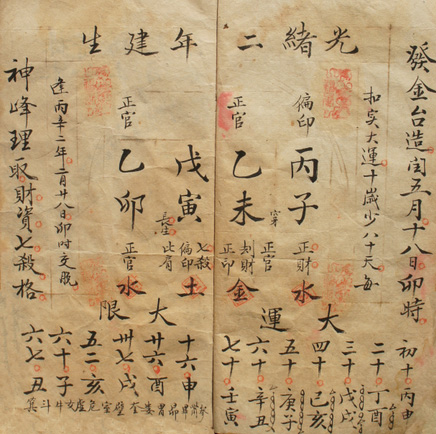 Ba Zi is an empirical model based on a set of Chinese Characters (consisting Yin/Yang, 5 Elements) that when constructed from our personal birth data (year, month, day, hour and place of birth) can provide us with great insight about ourselves (personality, talent, capacity, potential, etc.) and assist us in identifying milestones in our life to make informed decisions. It is called Ba Zi (八字) since it is based on eight characters for various representations of time associated with Tian (Heaven) and Di (Earth). An individual chart is constructed with a Heavenly Stem and Earthly Branch for each year, month, date, and time of birth. The combination of a Heavenly Stem and Earthly Branch for each parameter is called One Pillar; all together they are called the SiZhu 四柱, or Four Pillars. Each Pillar is composed of a Heavenly Stem and an Earthly Branch, so there are two characters per Pillar. With a total of Four Pillars, the entire chart is composed of eight characters. Therefore, a common name for Chinese astrology is BaZi 八字 (Eight Characters). Thus, for any particular individual there will be eight characters (BaZi) that reflect their personal energies. These are derived from all the Heavenly Stems and Earthly Branches within the Four Pillars that support the body. In other words, by understanding the energy of the macrocosmic Universe at that particular time, we can understand the microcosm of the individual. Accurate birth information is a must in order to prepare a precise life reading. It is vital to have the correct year, month, date, and time of birth when consulting a person’s astrological chart. The reading is much more difficult to be completely carried out if any of these components are missing or inaccurate.
Ba Zi is an empirical model based on a set of Chinese Characters (consisting Yin/Yang, 5 Elements) that when constructed from our personal birth data (year, month, day, hour and place of birth) can provide us with great insight about ourselves (personality, talent, capacity, potential, etc.) and assist us in identifying milestones in our life to make informed decisions. It is called Ba Zi (八字) since it is based on eight characters for various representations of time associated with Tian (Heaven) and Di (Earth). An individual chart is constructed with a Heavenly Stem and Earthly Branch for each year, month, date, and time of birth. The combination of a Heavenly Stem and Earthly Branch for each parameter is called One Pillar; all together they are called the SiZhu 四柱, or Four Pillars. Each Pillar is composed of a Heavenly Stem and an Earthly Branch, so there are two characters per Pillar. With a total of Four Pillars, the entire chart is composed of eight characters. Therefore, a common name for Chinese astrology is BaZi 八字 (Eight Characters). Thus, for any particular individual there will be eight characters (BaZi) that reflect their personal energies. These are derived from all the Heavenly Stems and Earthly Branches within the Four Pillars that support the body. In other words, by understanding the energy of the macrocosmic Universe at that particular time, we can understand the microcosm of the individual. Accurate birth information is a must in order to prepare a precise life reading. It is vital to have the correct year, month, date, and time of birth when consulting a person’s astrological chart. The reading is much more difficult to be completely carried out if any of these components are missing or inaccurate.
Shou Xiang | 手相
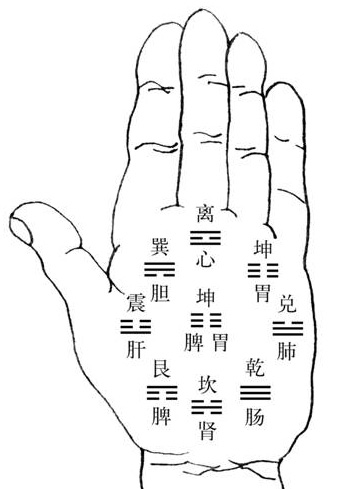 Adherents of this five phase system of palmistry believed and still do that appearances in the hand can reveal the san hou or three periods. In other words, one can examine a person’s past (xian zhen), the present (zai zhen), and their future (lai zhen). One can also read the hands for information about the four imports or si tong. This means that the appearances of the hands can reveal the mind (xin) or personality, the body (shen), the emotions and thoughts (yi), and the qi which unifies all these three. Thus practitioners of this five phase system of palmistry in addition to divination, could also diagnose the physical predispositions and ailments/illnesses of their subjects. Shou Xiang (or Palmistry) has a long history back to the Zhou Dynasty (1122–770 BCE). The earliest important discussion of palmistry is found in the Gu Ge Pian (Writings on the Skeleton), also known as Gu Xiang (Appearances on Bones), written by the scholar Wang Chong in the late part of the Han Dynasty (206 BCE–220 CE). Through history many schools were developed with the most important one being the Five Phases school.
Adherents of this five phase system of palmistry believed and still do that appearances in the hand can reveal the san hou or three periods. In other words, one can examine a person’s past (xian zhen), the present (zai zhen), and their future (lai zhen). One can also read the hands for information about the four imports or si tong. This means that the appearances of the hands can reveal the mind (xin) or personality, the body (shen), the emotions and thoughts (yi), and the qi which unifies all these three. Thus practitioners of this five phase system of palmistry in addition to divination, could also diagnose the physical predispositions and ailments/illnesses of their subjects. Shou Xiang (or Palmistry) has a long history back to the Zhou Dynasty (1122–770 BCE). The earliest important discussion of palmistry is found in the Gu Ge Pian (Writings on the Skeleton), also known as Gu Xiang (Appearances on Bones), written by the scholar Wang Chong in the late part of the Han Dynasty (206 BCE–220 CE). Through history many schools were developed with the most important one being the Five Phases school.
Mian Xiang | 面相
Mian Xiang, or Chinese face reading first appeared in 6th century B.C. By around 220 B.C, it became a part of the life of Chinese people. This method is used to study the personality, past and future prospects of a particular person. The art of face reading is much popular in Chinese medical practices as well. Chinese people believe that the face of a particular person represents his or her personality, health and fortune. They also believe that knowing these will help to live in peace with five elements (fire, wood, metal, earth and water), yin (females) and Yang (Males). There are many ways in face reading. 12 Houses, 108 Spots, 3 Quarters, 8 Trigrams are few methods. Also face reading is being done based on the shapes, colors as well.